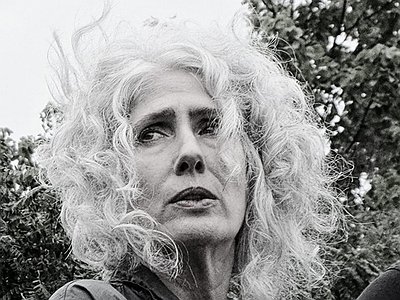Part 1
Name: Fides Krucker
Nationality: Canadian/Swiss
Occupation: Singer/Vocalographer/Teacher
Current Release: Vanishing (with Tim Motzer) on 1k Recordings
Recommendations: Secondhand Time by Svetlana Alexievich. It won the Nobel prize in literature in 2018. It’s about the fall of communism and the splitting apart of the USSR —the pain and passion of Glastnost (openness) Perestroika (restructuring) through verbatim interviews Alexiaevich conducted with a wide range of citizens, and then assembled and curated. The descent Alexievich charts is thorough, and at times unbearable. The fall of a fully embodied political structure and the loss and psychic damage due to this is astonishing. The capitalist gangsterism that replaced it has created a nostalgia for structures that previously gripped people in fear. / “Chorale Times Two” from the album Cage Machine by Paul Dresher. It is “Big and Beethoven” — an expression my daughter coined before she knew the words soulful or epic.
Fides has a comprehensive website www.fideskrucker.com where you can find out more about her work, teaching and writing.
When did you start writing/producing music — and what or who were your early passions and influences? What is it about music and/or sound that drew you to it?
My shift from interpreter to improviser, and then creator has been slow and organic — from adolescence to just shy of my 60th birthday.
My first love was for Bach: for clarity within complexity, his “bound” melodic cry. That rational love expanded through my 20s to embrace composers on the verge — those who could not escape the prickly moments — Beethoven, Schoenberg, Messiaen, Varèse. I feel such corporeal pleasure hearing the “falling apart” each of them risks and lays bare. And still they are masters of content and structure in relation to one another.
For most artists, originality is first preceded by a phase of learning and, often, emulating others. How would you describe your own development as an artist and the transition towards your own voice? What is the relationship between copying, learning and your own creativity?
I sang somewhat easily and without a fixed technique so I was invited to work on new operas in Canada and the US, as well as sing Luciano Berio’s work with orchestras in Europe by the time I was 26.
His “Folk Songs!” — more specifically his ex-wife Cathy Berberian’s joyous physiological inhabitation of all those vocal flavours — teased my insides even further away from Western singing ideals.
I met Richard Armstrong at the Banff Centre, and his brilliant opening up of what I now call “expanded” voice gave me radical food for vocal thought and justified emotional impulse.
I improvised for the next few decades so that (more often male) composers could write electroacoustic operatic works. I found these artists stimulating, original and creative, and counted myself lucky.
In my early 30s, I created a women’s collective. The six of us used music to lead non-narrative theatrical creation using the life-stuff that we dared to reveal to one another as our point of departure. Not the dying or going mad that female characters face in the operatic world, but the mundane experience of everyday ups and downs.
Improvisation became mine through expressing how I was doing as a woman — being in relationship, having babies, breaking up, making a career in a world not shaped by women — true nature bubbling to the surface.
Realizing that I have been making my own music has been gradual. Improvising for contemporary opera composers wasn’t recognized as a co-compositional act through most of my career. It was Maria Meindl, the first editor of my voice book, who underlined that in-rehearsal acts of creation are acts of authorship.
How do you make use of technology? In terms of the feedback mechanism between technology and creativity, what do humans excel at, what do machines excel at?
I consider it a great gift to have done a fair bit of electroacoustic work: Michael Maguire, Gavin Bryars, Susan Frykberg, Wende Bartley, Barry Truax, and in the 21C, Louis Dufort and Maurizio Squillante. The untethering of music from traditional instruments was magnificent support for untethering the female voice from ‘bel canto’ ideals. The granulating of sound, the spreading out of rhythm, those things allowed me to go into texture without apology. Instead of feeling a count of 4/4, I learned to span seconds and minutes as concrete corporeal time.
When I start from the lowest notes of my range, I don’t think of singing a low D and then sweeping up three octaves to a high D — I think of grunt, groan, moan, sigh, laugh, sob, holler, shriek, scream, and squeal. It might not sound like those non-verbals are what I am sounding in every moment but the permission for me to express those raw states as a “civilized” woman is what I need to unchain vocal truth. And then I tidy it up a little, using key, pitch, repetition, variation, unfolding, consequence, etc. to make it palpable to the mind as well as indicative of the body.
Reclaiming taboo sounds becomes a way to bring the human machine (the autonomic nervous system) back into play and through that I find working with manmade machines expansive and enjoyable.
Collaborations can take on many forms. What role do they play in your approach and what are your preferred ways of engaging with other creatives through, for example, file sharing, jamming or just talking about ideas?
I like to be in the studio with another breathing human whether improvising, creating textural non-verbal vocal scores for dancers, or facilitating dance or theatre. I love it when there is that “click” with another artist that allows follow and lead to feel the same. That was there with Tim the first time we met in Toronto after a show he had played for the Canadian choreographer Peggy Baker. We had a musical blind date in front of a post-show audience and decided right away to record.
Of course, we are all teaching and creating on Zoom right now. It works — and with more nuance and humanity than I could have imagined — but I can’t wait to get back to sharing air.
Could you describe your creative process on the basis of a piece or album that's particularly dear to you, please? Where did the ideas come from, how were they transformed in your mind, what did you start with and how do you refine these beginnings into the finished work of art?
Vanishing (my collaborative album with Tim Motzer, guitarist) is one of those pieces.
Tim and I went into his studio in Fishtown (Philadelphia, Pennsylvania) each day for a week. We talked about our life experiences quite broadly and through this revealed individual values and artistic passions. It was 2017 and though only 20 months into Trump’s presidency the state of our worlds — north and south of the border — felt increasingly precarious and imperiled. We weren’t “happy.” We felt that we were losing things we treasured… that they were vanishing.
The result is extremely personal — sometimes frail and sometimes hearty. It is also communal in that Tim and I seem to listen extremely non-judgmentally to what each other has to offer during the act of making. There is a current and it flows easily over rocks… and if it snags, the snag is also worth exploring.
My personal interest was to allow my voice to lead in our musical discussion through following visceral and sense-based impulses. I was recovering from a torn strap muscle in my neck, and I didn’t want to cover that up. I allowed my voice to express its (our) vulnerable relationship to an essential, broken, and previously “taken for granted” structure — such a fine little strap muscle, one that supports the larynx. I let my cords get to know each other afresh and without apology, defense or measuring up. My mind and body found new ways to tell the truth through the simplicity of breathing and listening and sounding. I felt like my voice and I did not fail one another, that creativity and connection are possible within a shifting structure.
It is an understatement to say that the sonic worlds Tim creates and thrives in provided great safety, sensuality, curiosity and inspiration.






